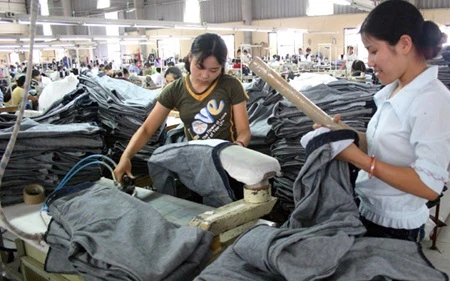Hanoi (VNA) – The Vietnam National Textile and Garment Group (Vinatex) will strive to raise the local content of its products to 60 percent as of 2018, the year when the TPP and the Vietnam-EU FTA are expected to take effect.
Chairman of Vinatex Tran Quang Nghi said only by doing so can the group meet the requirements of these two new-generation FTAs in order to fully benefit from preferential tariffs.
Towards the goal, the group recently put into operation two yarn making factories and a dyeing-weaving plant. A yarn factory in northern Nam Dinh province is scheduled to be launched in the first quarter of this year, while preparations are underway for a yarn-dyeing-weaving complex in the central province of Quang Nam. The complex will supply around 12,000 tonnes of knitted material a year.
Six other garment making plants are also slated to be completed in the first half of this year.
However, managers in the textile and garment sector said it will take some time before the new generation FTAs can actually bring any benefit, as both the TPP and the EV FTA have to wait for parliament approval in member countries and other time-consuming preparation procedures.
Therefore, 2016 will still be a year of many challenges for the sector, more so when 2016 is forecasted as a year of fluctuations in the financial market and the world’s pace of growth.
According to Vinatex General Director Le Tien Truong, except for the US, other major markets such as Europe and Japan show signs of low economic growth, which means global demand will stay at around the same level as in 2015.
In addition, crude oil price is believed will remain low, resulting in low prices of materials such as synthetic fibre. Subsequently, the price of natural fibre is expected to drop to compete.
Therefore, Truong said it is hardly possible that order value will increase in 2016. In such circumstances, the sector’s export value can only be driven by growth in output, which is estimated at 11-12 percent.
Nguyen Xuan Duong, General Director of Hung Yen Garment Company (Hugaco), said the move of other countries in the region to devaluate their domestic currencies has reduced their production costs compared to Vietnam’s. Hence, customers might switch orders to other countries in the region, including Indonesia, Myanmar or even China, he said.
In 2015, Vietnam remained in the top five largest apparel exporters, raking in 27 billion USD, which was 500 million USD short of the target.
General Director Le Tien Truong estimated the sector’s export turnover for this year at 29.5-30 billion USD.-VNA
























